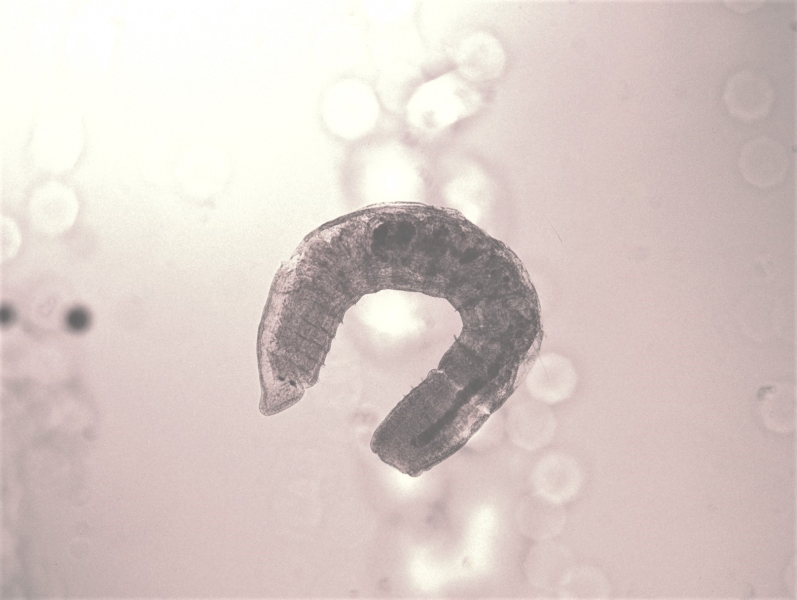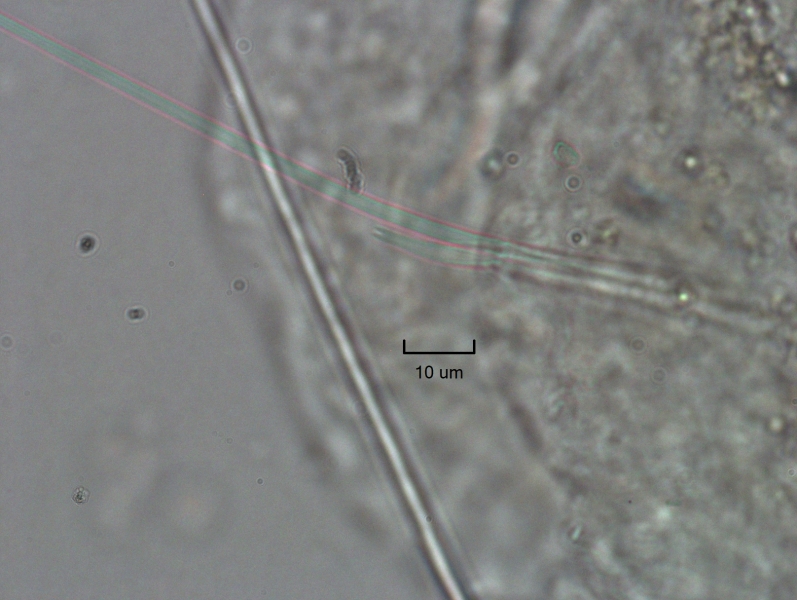Nais variabilis
Taxa description
Nais variabilis Piguet, 1906 is a freshwater oligochaete worm that is very common in the Great Lakes. It is a naidid worm with dorsal bundles beginning in VI and ventral bundles beginning in II, hair chaetae in the dorsal bundles, and without a proboscis. Worms in the genus Nais all have 1–2 hair and needle chaetae in each dorsal bundle with simple-pointed or bifid needles; the ventrals usually change between V and VI, often quite dramatically. N. variabilis has dorsal bundles with 1–2 hair chaetae and 1–2 bifid needles with equal, parallel teeth. The teeth on the needle may need to be viewed at 100X to distinguish. Anterior ventral bundles of II–V have chaetae with thin, curved upper teeth that are about twice as long as the lower tooth. Starting in VI, there are variable chaetae which may have a thin upper tooth as long as or slightly shorter than the lower tooth. The nodulus on ventral chaetae is median from II–V and distal posteriorly. Some specimens of N. variabilis have extremely long hair chaetae (up to 700 μm instead of the typical 200–300 μm), while others have quite variable chaetae. If mature, there are 2–3 penial chaetae per bundle. There may or may not be eyes, and the stomach widens abruptly. It is possible that N. variabilis may be a species complex with several other Nais species like N. communis, N. bretscheri, and N. pardalis.
Distinguishing features
N. variabilis is identified by dorsal bundles starting in VI, few hairs and bifid needles in dorsal bundles, ventral chaetae changing shape at VI, anterior ventral chaetae with thin, curved upper teeth, posterior ventral bundles are variable but mainly have short, thin upper teeth that are equal or subequal to the lower. N. variabilis may or may not have eyes.
Habitat
Lake occurrence
Lakes Erie, Huron, Michigan, and Ontario.
Similar species
N. variabilis may be a species complex including several other Nais species. N. pardalis and N. bretcheri may be part of this complex as well. They have variable chaetae but a main difference is that both of those species have enlarged or giant posterior ventral chaetae with upper teeth twice as long or much longer than the lower tooth, which is very short or rudimentary on the giant chaetae. N. pardalis and N. bretscheri may also have more normal posterior chaetae with upper teeth equal to the lower tooth. If giant or enlarged chaetae are missing, they are hard to distinguish from N. variabilis. All three species have anterior ventral chaetae with a long, curved upper tooth and a shorter lower tooth, with the upper tooth about twice as long as the lower. The bifid teeth on the needle chaetae are easier to distinguish on N. pardalis and N. bretscheri, so they will be visible at lower magnification. In general, N. bretscheri is defined by having at least some giant chaetae with upper tooth much longer than the lower short or rudimentary tooth, and N. pardalis has enlarged chaetae or chaetae with the upper tooth 2–3 times as long as the lower tooth, while N. variabilis has teeth that approximately equal in length. There may be seasonal or spatial variation in the chaetae contributing to the confusion between these species.
N. communis may be part of the N. variabilis complex as it is often confused with Nais variabilis and there are some specimens with overlapping characteristics that are sometimes simply called N. communis/variabilis. For N. communis, anterior ventral bundles of II–V have 2–6 chaetae with teeth of equal length. There is not much change in shape at VI and posterior, unlike most other Nais species, except that the placement of the nodulus may be median anteriorly and distal posteriorly. N. communis usually has eyes, while N. variabilis may lack eyes. The needle chaetae of N. communis are bifid and the teeth can be seen at 40X, but in N. variabilis the teeth may need to be viewed at 100X to be seen. The nodulus on the anterior chaetae of N. communis is median, while the nodulus on the anterior chaetae of N. variabilis is below the median (closer to proximal end); in both species, the nodulus of the posterior chaetae is distal. The hair chaetae of N. variabilis are usually longer and thicker than N. communis. Lastly, though this may be hard to see, the stomach of N. communis widens gradually, while in N. variabilis the stomach widens abruptly.
Some specimens of Dero will key out to N. communis or N. variabilis if they are missing a posterior end since both genuses have 1–2 hairs with 1–2 bifid needles and dorsal bundles starting in V or VI. Specimens belonging to Dero sp. are most likely to Dero digitata, D. obtusa, and D. nivea. D. digitata has needle chaetae with the upper tooth longer than the lower, whereas N. communis or N. variabilis will have even teeth. Another distinguishing factor is the ventral chaetae: D. digitata does experience a difference between anterior and posterior ventrals, and the anteriors are longer and thinner with upper teeth longer than the lower; N. variabilis is quite similar, but the posterior chaetae have a much thicker lower tooth, although there is much variation in the ventral chaetae of this species; N. communis does not have much difference between anterior and posterior chaetae, so the anterior chaetae do not have upper teeth longer than the lower. D. obtusa and D. nivea both have equal teeth on their needle chaetae, but their body size and the length of the anterior ventrals can help distinguish them. If a specimen is missing the posterior end but aligns with other factors for Dero but not a specific species, call it Dero sp.
Relative size
N. variabilis is a small freshwater oligochaete.
Does it have a barcode reference from the Great Lakes?
Yes, this species does have a barcode reference from the Great Lakes.
References
Kathman, R.D., and R.O. Brinkhurst. 1998. Guide to Freshwater Oligochaetes of North America. pp. 88–89, 40, 66–75, 80–89.
Hiltunen, J.K., and D.J. Klemm. 1980. A Guide to the Naididae (Annelida: Clitellata: Oligochaeta) of North America. pp. 23, 22–24, 35.




